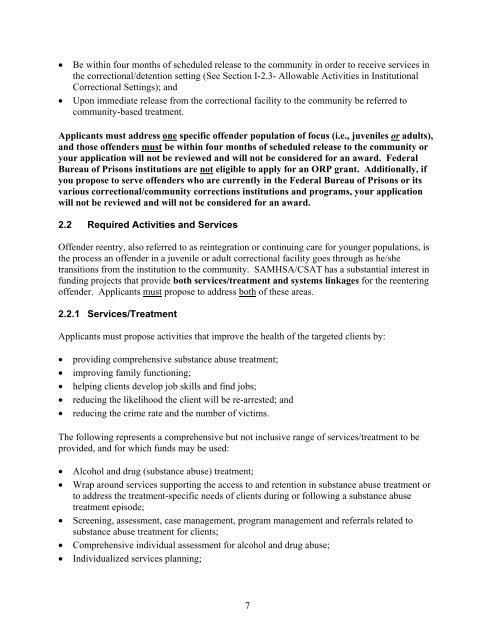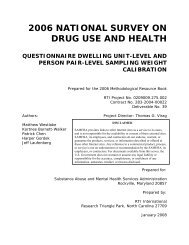Download Complete RFA Announcement TI-10-006 in PDF format
Download Complete RFA Announcement TI-10-006 in PDF format
Download Complete RFA Announcement TI-10-006 in PDF format
Create successful ePaper yourself
Turn your PDF publications into a flip-book with our unique Google optimized e-Paper software.
Be with<strong>in</strong> four months of scheduled release to the community <strong>in</strong> order to receive services <strong>in</strong><br />
the correctional/detention sett<strong>in</strong>g (See Section I-2.3- Allowable Activities <strong>in</strong> Institutional<br />
Correctional Sett<strong>in</strong>gs); and<br />
Upon immediate release from the correctional facility to the community be referred to<br />
community-based treatment.<br />
Applicants must address one specific offender population of focus (i.e., juveniles or adults),<br />
and those offenders must be with<strong>in</strong> four months of scheduled release to the community or<br />
your application will not be reviewed and will not be considered for an award. Federal<br />
Bureau of Prisons <strong>in</strong>stitutions are not eligible to apply for an ORP grant. Additionally, if<br />
you propose to serve offenders who are currently <strong>in</strong> the Federal Bureau of Prisons or its<br />
various correctional/community corrections <strong>in</strong>stitutions and programs, your application<br />
will not be reviewed and will not be considered for an award.<br />
2.2 Required Activities and Services<br />
Offender reentry, also referred to as re<strong>in</strong>tegration or cont<strong>in</strong>u<strong>in</strong>g care for younger populations, is<br />
the process an offender <strong>in</strong> a juvenile or adult correctional facility goes through as he/she<br />
transitions from the <strong>in</strong>stitution to the community. SAMHSA/CSAT has a substantial <strong>in</strong>terest <strong>in</strong><br />
fund<strong>in</strong>g projects that provide both services/treatment and systems l<strong>in</strong>kages for the reenter<strong>in</strong>g<br />
offender. Applicants must propose to address both of these areas.<br />
2.2.1 Services/Treatment<br />
Applicants must propose activities that improve the health of the targeted clients by:<br />
<br />
<br />
<br />
<br />
<br />
provid<strong>in</strong>g comprehensive substance abuse treatment;<br />
improv<strong>in</strong>g family function<strong>in</strong>g;<br />
help<strong>in</strong>g clients develop job skills and f<strong>in</strong>d jobs;<br />
reduc<strong>in</strong>g the likelihood the client will be re-arrested; and<br />
reduc<strong>in</strong>g the crime rate and the number of victims.<br />
The follow<strong>in</strong>g represents a comprehensive but not <strong>in</strong>clusive range of services/treatment to be<br />
provided, and for which funds may be used:<br />
<br />
<br />
<br />
<br />
<br />
Alcohol and drug (substance abuse) treatment;<br />
Wrap around services support<strong>in</strong>g the access to and retention <strong>in</strong> substance abuse treatment or<br />
to address the treatment-specific needs of clients dur<strong>in</strong>g or follow<strong>in</strong>g a substance abuse<br />
treatment episode;<br />
Screen<strong>in</strong>g, assessment, case management, program management and referrals related to<br />
substance abuse treatment for clients;<br />
Comprehensive <strong>in</strong>dividual assessment for alcohol and drug abuse;<br />
Individualized services plann<strong>in</strong>g;<br />
7
















